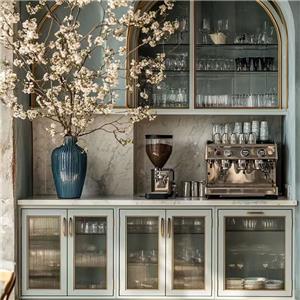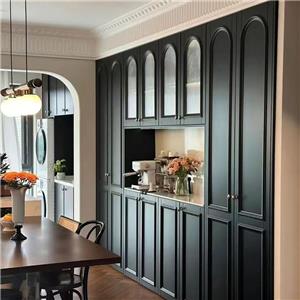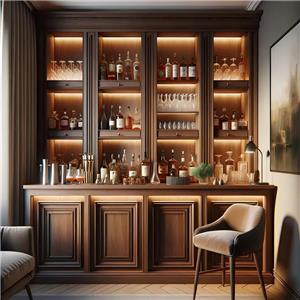What flooring should be laid under the kitchen cabinet?
The kitchen is one of the most frequently used and busiest spaces in the home. Whether it is preparing a delicious dinner or cleaning up grease and debris, the functionality and durability of the kitchen are particularly important. As an important part of the entire kitchen space, the kitchen floor must not only be beautiful, but also have multiple functions such as durability, easy cleaning, and non-slip. The choice of flooring under the kitchen cabinet cannot be ignored, because it not only affects the comfort of the kitchen, but also affects the overall aesthetics and convenience of cleaning and maintenance.
When choosing the flooring to be laid under the kitchen cabinet, owners often face a variety of choices, and different flooring materials have different advantages and disadvantages. Therefore, how to choose the right flooring to be laid under the cabinet has become a problem that many owners need to seriously consider when decorating.
This article will explore the selection criteria for laying flooring under the kitchen cabinet from multiple perspectives, and analyze the advantages and disadvantages of different materials to help you make more informed decisions when designing the kitchen.
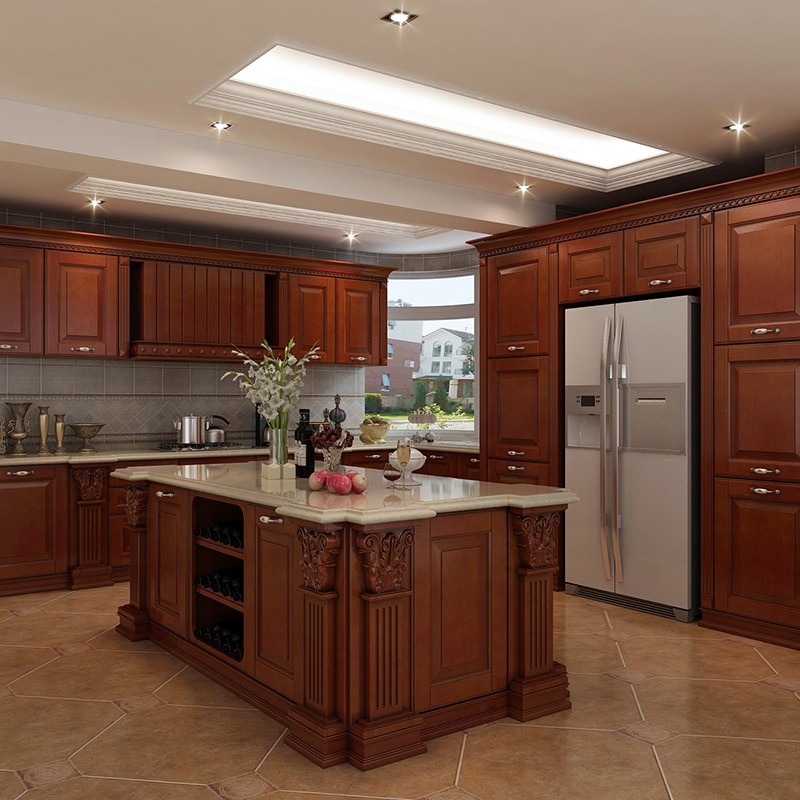
What are the considerations for the flooring laid under the kitchen cabinet?
When considering the choice of flooring under the kitchen cabinet, we must first clarify the basic requirements for the kitchen floor. As a place that is frequently used and easily affected by moisture, the kitchen floor needs to have some basic characteristics:
● Water resistance: The kitchen is a place that is prone to water vapor, splashing and oil stains, so the kitchen cabinet floor must have good water resistance to prevent the floor from swelling or damage due to water vapor penetration.
● Easy to clean: During cooking, oil smoke and food residues often fall on the ground. Kitchen floors should be made of materials that are easy to clean and do not absorb oil stains.
● Anti-slip: The kitchen floor is often slippery, especially when cleaning. Therefore, the floor should have good anti-slip properties to prevent people from slipping when working in the kitchen.
● Wear resistance: The kitchen is a place with high-intensity use. The floor needs to withstand high-frequency daily use, including standing, walking, carrying heavy objects, etc., to avoid wear due to frequent friction.
● Durability: Considering the special use environment of the kitchen cabinet, the floor should have a long service life to reduce the trouble caused by frequent replacement of the floor.
● Aesthetics: The floor should not only be functional, but also be able to match the overall kitchen design style to enhance the beauty of the kitchen space.
After understanding the basic requirements of kitchen flooring, we will discuss the types of flooring materials and corresponding selection criteria for laying under the kitchen cabinet.
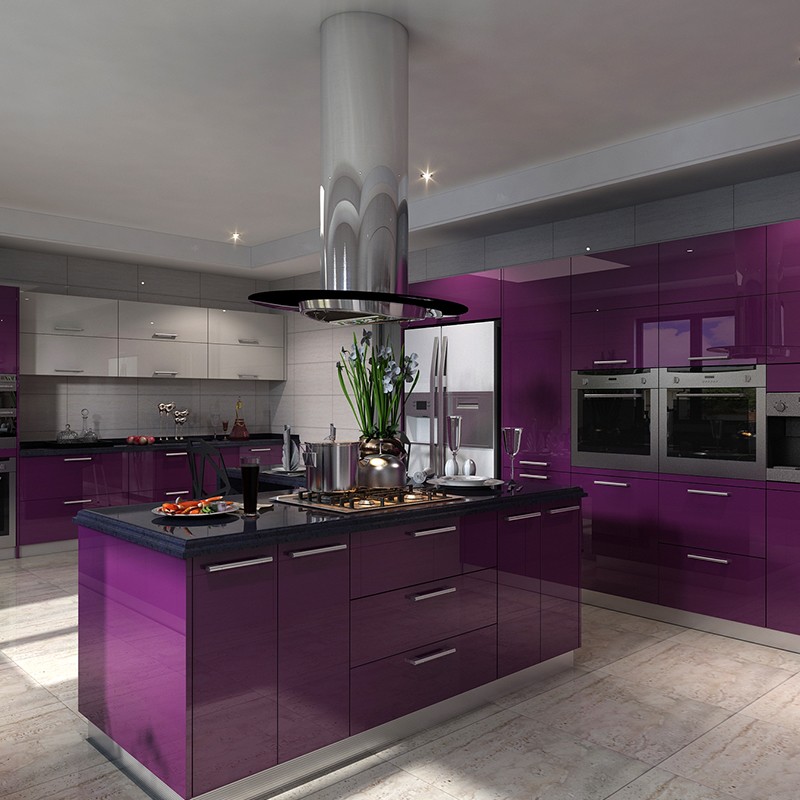
Common kitchen flooring materials and their advantages and disadvantages
The floor under the kitchen cabinet usually needs to be durable and easy to clean. The following are several common kitchen flooring materials, each with different advantages and disadvantages:
1. Ceramic tile flooring
As the most common choice for kitchen cabinet flooring, ceramic tile flooring is popular for its water resistance, wear resistance and easy cleaning. Ceramic tile can provide a very good waterproof effect in the kitchen, and its surface is smooth and not easy to accumulate oil stains.
Advantages:
● Strong waterproofness: ceramic tile hardly absorbs water, and water stains will not penetrate into the floor.
● Easy to clean: The surface of the ceramic tile is flat, and oil stains, food residues, etc. are not easy to adhere, which is very convenient to clean.
● Good wear resistance: The surface of the ceramic tile is hard and has strong wear resistance. Even if it is used for a long time, it is not easy to produce scratches.
● Rich styles: There are various styles, colors and patterns of ceramic tiles on the market to meet different kitchen design needs.
Disadvantages:
● High hardness: The hardness of the tile is relatively high. If heavy objects are dropped, the tile is easily damaged.
● Poor anti-slip performance: Although the tile has good wear resistance, the surface of some tiles may be slippery, which may easily cause falls in a slippery environment.
● Applicable scenarios: If you choose tile flooring as the paving material under the kitchen cabinet, it is recommended to choose textured tiles with anti-slip effect to avoid accidents.
2. Wood flooring (solid wood flooring/laminated wood flooring)
Wood flooring has a warm and natural appearance, suitable for creating a warm and elegant kitchen environment. In particular, laminate wood flooring has gradually become a popular choice for kitchen decoration due to its durability.
Advantages:
● Strong aesthetics: The natural texture and color of the wood flooring make the kitchen look warmer and more layered.
● Good comfort: The wood flooring has a certain elasticity and feels comfortable to walk on, especially for people who stand and work for a long time.
● Good sound insulation: The wood flooring can effectively reduce noise and make the kitchen environment more peaceful.
Disadvantages:
● Not water-resistant: Wood floors, especially solid wood floors, are prone to swelling due to moisture. Long-term exposure to water vapor and oil may cause deformation and cracking.
● Easy to wear: The surface of wooden floors is relatively soft and is easily scratched or heavy objects fall.
● Applicable scenarios: If you want to use wooden floors under kitchen cabinets, it is recommended to choose composite wood floors and maintain them regularly to avoid damage to the floor caused by water vapor and moisture.
3. Vinyl flooring (PVC flooring)
Vinyl flooring, also known as PVC flooring, has become a common choice for kitchen floors due to its excellent waterproof, anti-slip and wear-resistant properties. This material is usually processed from synthetic resins such as polyvinyl chloride and has good elasticity and anti-slip effects.
Advantages:
● Strong waterproofness: Vinyl flooring has very good waterproofness and is suitable for the humid environment of the kitchen.
● Comfort: Vinyl flooring is elastic and very comfortable to walk on, reducing the fatigue of standing for a long time.
● Wear resistance: It has strong wear resistance and can withstand high-intensity use in the kitchen.
Disadvantages:
● Possible discoloration: Vinyl flooring may fade if exposed to sunlight for a long time.
● Easy to scratch: Although vinyl flooring is wear-resistant, it will leave obvious marks if scratched accidentally.
● Applicable scenarios: PVC flooring is suitable for high-frequency use areas in the kitchen, especially in home kitchens. Its waterproof and comfortable properties make it an ideal choice under the kitchen cabinet.
4. Rubber flooring
As a durable and anti-slip flooring material, rubber flooring is widely used in high-frequency use places such as commercial kitchens and restaurants. Its elasticity and anti-slip properties are very suitable for high-humidity and high-intensity operating environments such as kitchens.
Advantages:
● Strong anti-slip performance: The anti-slip effect of rubber flooring is very good, which can effectively prevent falls caused by slippery floors in the kitchen.
● Good durability: Rubber flooring can withstand heavy objects falling and frequent friction, and has a long service life.
● Good shock absorption effect: Its elastic properties help reduce pressure on the knees and back, and is suitable for people who stand in the kitchen for a long time.
Disadvantages:
● Limited color options: Although rubber flooring is very functional, it has relatively few color and design options in terms of aesthetics, and may not be suitable for kitchen designs that pursue high aesthetics.
● Applicable scenarios: Rubber flooring is suitable for commercial kitchen cabinets, large-scale catering industries, and home kitchens that focus on anti-slip and durability.

Tips for matching the floor under the kitchen cabinet
After determining the floor material, the choice of floor under the kitchen cabinet also needs to consider the matching with the cabinets, countertops and overall kitchen style. Here are a few matching tips to help you choose the right floor:
● Coordinate with the style of the kitchen cabinet: Modern-style kitchens usually use smooth, simple tiles or PVC floors, while traditional-style kitchens can be matched with wooden floors or retro-style brick floors.
● Match with the countertop material: If the countertop is made of natural stone (such as marble, granite), you can choose dark tiles that contrast with the countertop; if the countertop is made of wood, you can choose wooden floors with similar tones.
● Focus on functionality: The floor under the kitchen cabinet should not only consider beauty, but also give priority to practicality. For example, choosing materials with strong anti-slip properties can increase the safety of the kitchen and prevent slipping when cleaning.
● Color matching: The color of the kitchen floor should be coordinated with the color of the kitchen cabinet. If the cabinet is dark, you can choose a light-colored floor to avoid the sense of oppression in the space; conversely, dark kitchen cabinets with dark floors can enhance the sense of calmness in the kitchen.
At Gagaluna, we combine over 18 years of experience with a passion for innovation in the field of custom kitchen cabinetry. Located in Foshan, China, we specialize in creating bespoke kitchen cabinets, wardrobes, bookshelves, bar cabinets, and more, using a wide variety of materials, including stainless steel, glass, aluminum, and acrylic. Our factory guarantees affordable prices without compromising on quality. Take advantage of our sales, promotions, and attractive discounts to get the best prices in the market. Let us provide you with high-quality products and unparalleled customer service.

